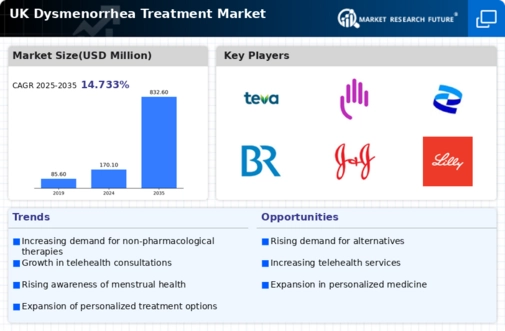The UK Dysmenorrhea Treatment Market has witnessed significant evolution over the past several years, characterized by a growing awareness of menstrual pain management and an increasing demand for effective solutions. As dysmenorrhea, commonly known as painful periods, affects a considerable percentage of the female population, pharmaceutical companies are actively working to develop innovative treatments that meet this need. The competitive landscape is marked by a mix of established players and emerging companies, each vying for market share through product development, strategic partnerships, and customer engagement initiatives.
Additionally, the regulatory environment and focus on patient-centered care are driving companies to adapt their strategies to enhance their offerings and meet the expectations of healthcare providers and patients alike. GlaxoSmithKline stands out in the UK Dysmenorrhea Treatment Market with a robust portfolio of products aimed at alleviating menstrual pain.
The company has leveraged its exceptional research capabilities to develop formulas that address various aspects of dysmenorrhea, thereby enhancing the efficacy of pain management solutions available in the UK. GlaxoSmithKline's strength lies in its extensive market presence and brand recognition, allowing it to establish trust and loyalty among healthcare professionals and patients.
The company's commitment to maintaining high standards of quality and safety in its products has strengthened its competitive position. Furthermore, through targeted marketing strategies and collaborations with healthcare providers, GlaxoSmithKline continues to reinforce its position in the market and address the evolving needs of women experiencing menstrual discomfort. Teva Pharmaceutical also plays a significant role in the UK Dysmenorrhea Treatment Market, offering a range of generics and specialty medicines designed to effectively manage pain.
The company's key products for dysmenorrhea treatment include non-steroidal anti-inflammatory drugs (NSAIDs) and other pain relief options that are integral to addressing menstrual pain. Teva Pharmaceutical's strengths lie in its comprehensive manufacturing capabilities and extensive distribution networks, ensuring widespread availability of its products across the UK.
The company has strategically pursued mergers and acquisitions, bolstering its product portfolio and consolidating its market position. This approach has enhanced Teva's ability to innovate and respond to market demands promptly. Overall, Teva Pharmaceutical’s commitment to delivering affordable and effective treatment options continues to make it a formidable player in the dysmenorrhea treatment sector in the UK.






















Leave a Comment